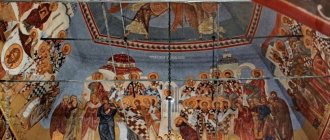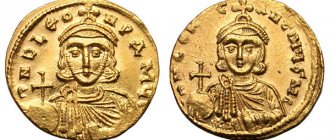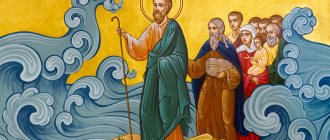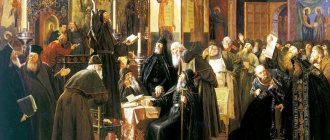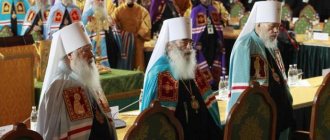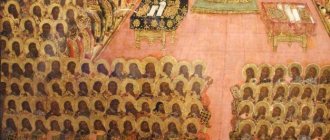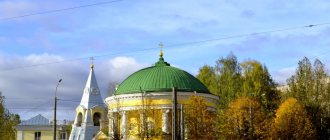Progress [edit]
| This section requires additional links for verification . |
Further information: Three-chapter controversy.
The Council was presided over by Eutyches, Patriarch of Constantinople, assisted by three other Eastern patriarchs or their representatives. [5] Pope Vigilius was also invited; but even though at this time he was residing in Constantinople (to avoid the dangers of life in Italy, shaken by the war against the Ostrogoths), he refused to attend and even issued a document forbidding the council to proceed without him (his "First Constitutum"). For more details, see Pope Vigilius. [ citation needed
]
However, the council continued without the Pope condemning the Three Chapters. And during the seventh session of the council, the bishops expelled Vigilius from the diptychs for his refusal to appear at the council and approve his work, effectively excommunicating him personally, but not the rest of the Western Church. Vigilius was then imprisoned in Constantinople by the emperor and his advisors were exiled. However, six months later, in December 553, he agreed to condemn the Three Chapters, claiming that his hesitation was caused by the misleading of his advisers. [4] His approval of the council was expressed in two documents (a letter to Eutychius of Constantinople, December 8, 553, and a second Constitutum, dated February 23, 554, probably addressed to the Western episcopate), condemning the Three Chapters, [6] according to him at our own discretion and without reference to advice. [3]
In Northern Italy, the ecclesiastical provinces of Milan and Aquileia broke off communication with Rome. Milan did not accept the verdict until the end of the sixth century, while Aquileia did not do so until 700. [3] [7] The rest of the Western Church accepted the council's decrees, although without much enthusiasm. Although it is considered one of the ecumenical councils, in the West it never received the status of either Nicaea or Chalcedon.
In Visigothic Spain (Reccared had recently converted to Christianity) the churches never accepted the council; [8] when news of the subsequent Third Council of Constantinople was transmitted to them from Rome, it was perceived as the fifth
Ecumenical Council, [9] not the sixth.
Isidore of Seville, in his Chronicle
and
De Viris Illustribus,
recognized Justinian as a tyrant and persecutor of the orthodox [10] and a fan of heresy [11], contrasting him with Facundus of Hermiana and Victor of Tunnuna, who was considered a martyr. [12]
Despite the conflict between the council and the pope and the failure to reconcile Chalcedonians and non-Chalcedonians, the council still made significant theological contributions. The canons condemning the Three Chapters were preceded by ten dogmatic canons, which defined Chalcedonian Christology with new precision, emphasizing that God the Word is the sole subject of all Christ's actions, divine and human [ citation needed
] .
The "two natures" defined at Chalcedon were now clearly interpreted as two sets of attributes possessed by one person, God Christ, the Second Person of the Trinity. [13] Later Byzantine Christology, found in Maximus the Confessor and John of Damascus, was built on this basis. Moreover, this might have been sufficient to reunite the Chalcedonians and non-Chalcedonians had it not been for the breakdown of ties between the two groups resulting from the Muslim conquests in the next century. [ citation needed
]
Ecumenical Councils - what are they?
The original meaning of the word “cathedral” is “meeting, congress.” Today, the word is used in this meaning only in the church lexicon. Ecumenical councils are meetings of the hierarchs of the Orthodox Church in its universal completeness for the purpose of discussing church-wide dogmatic, canonical and disciplinary issues.
First Ecumenical Council (Orthodox icon)
The participants of the council are mostly bishops representing individual Local Churches. Bishops are the successors of the apostles, bearers of special grace. Therefore, their congregation makes decisions not on its own, but under the guidance of the Holy Spirit. In this regard, the provisions of the Ecumenical Councils are recognized as true and binding for all autocephalous Churches. Thus, the Ecumenical Council is the body of the highest church authority.
For a Council to receive Ecumenical status, it must pass the test of time. It is necessary that all Local Churches recognize its decrees as consistent with God's Law and the norms of church government. Some meetings, under pressure from emperors or influential bishops, made decisions that were contrary to Orthodox doctrine. Subsequently, such Councils were rejected by the Church. They were assessed as illegitimate, and their decisions were not accepted by world Christianity. These cathedrals are usually called “robber cathedrals”.
Acts [edit]
The original Greek acts of the Council are lost, [14] but there exists an old Latin version, possibly made for Vigilius, of which there is a critical edition [15] and now an English translation and commentary [16]. it was claimed (probably falsely) that the original Acts of the Fifth Council were forged [17] in favor of monothelitism. [3] It has previously been argued that the extant acts are incomplete because they do not mention the discussion of Origenism. However, the generally accepted view today is that the bishops signed the canons condemning Origenism before the council officially opened. [18] This condemnation was confirmed by Pope Vigilius, and the subsequent Ecumenical Council (the third Council of Constantinople) gave its “assent” in its Definition of Faith to five previous synods, including “... the last, that is, the Fifth Holy Synod, assembled in this place, against Theodore Mopsuestian, Origen, Didymus and Evagrius ... "; [19] Its full conciliar authority is questioned only in our time. [20]
In the Melkite Chronicles
641 there is a Syrian account of the council [21].
Prayers to the Holy Fathers of the Ecumenical Councils
Troparion to the Holy Fathers of the Six Ecumenical Councils, tone 8
Glorified art thou, O Christ our God,/ our founding fathers of light on earth,/ and through them instructing all of us to truer faith, // Most gracious, glory to Thee.
Translation:
Glorified are You, Christ our God, as you established the lights on earth of our fathers and through them guided us all on the path of true faith, O Most Merciful, glory to You!
Kontakion to the Holy Fathers of the Six Ecumenical Councils, tone 8
Apostle preaching and father of dogma/ Seal to the one faith of the Church,/ even wearing the robe of truth, which came from above theology,// corrects and glorifies the great piety ness.
Translation:
The preaching of the Apostles and Fathers established the dogmas of a single faith for the Church; and she, wearing the robe of truth, woven from heavenly Theology, correctly teaches and glorifies piety the great sacrament.
Troparion to the Holy Fathers of the Seventh Ecumenical Council, tone 2
We worship your most pure image, O Good One, / asking forgiveness of our sins, O Christ God: / for it was your will that you should ascend in flesh to the Cross, / that you might deliver from the work of the enemy life./ Thus we cry out to You in gratitude:/ You have filled all with joy, O our Savior ,// came to save the world.
Translation:
We worship Your most pure image, O Good One, asking forgiveness of our sins, O Christ God. For You voluntarily deigned to ascend in the flesh to the Cross in order to deliver those created by You from slavery to the enemy. Therefore, we gratefully cry out to You: “You have filled everything with joy, our Savior, who came to save the world!”
Notes[edit]
- ^ab "NPNF2–14. Seven Ecumenical Councils, Introduction". CCEL. Retrieved August 23, 2014.
- (3 names, 3 bishops and 145 others, plus 1 Pope, total 152)
- See, for example,
Lutheran-Orthodox Joint Commission, Seventh Session, Ecumenical Councils, General Statement, 1993,
available at
Lutheran-Orthodox Joint Commission (BI 5a. "We agree with the doctrine of God, the Holy Trinity, as formulated by the Ecumenical Councils of Nicaea and Constantinople and on the doctrine of the person of Christ formulated by the first four Ecumenical Councils." - ^ abcd One or more of the preceding sentences incorporates text from a publication now in the public domain: Thomas J. Shahan (1913). "Council of Constantinople." In Herbermann, Charles (ed.). Catholic Encyclopedia
. New York: Robert Appleton Company. - ^ abcd Leo Donald Davis (1983), "Chapter 6 Council of Constantinople II, 553", The First Seven Ecumenical Councils (325–787): Their History and Theology
, Collegeville, Minnesota: Liturgical Press, pp. 242–248, ISBN 978- 0814656167, access date 08/23/2014 - Jump up
↑ Meyendorff 1989, pp. 241–243. - Mansi, Sacrorum Conciliorum nova et ampissima collectio
, vol.
IX, pp. 414–420, 457–488; Wed Hefele, Conciliengeschichte
, vol. II, pp. 905–911. - Hefele, Conciliengeschichte
, vol. II, pp. 911–927. (For a fair assessment of Vigilius' conduct, see, besides the article VIGILIUS, Bois's decision in Diet. De theol. Cath., II, 1238–1239.) - Herrin (1989)pp. 240-241
- Herrin (1989) p. 244
- Herrin (1989) p. 241 and references therein
- ↑
Isidore of Seville,
Chronica Maiora
, no. 397a - Herrin (1989) p. 241
- Price (2009) vol. I, pp. 73–75
- “NPNF2–14. Seven Ecumenical Councils, Excursion on the authenticity of the acts of the Fifth Council". Christian Classical Ether Library. June 1, 2005. Retrieved August 23, 2014.
- Straub, Johannes (1971), Acta Conciliorum Oecumenicorum. Tomus IV, Volume I
, Berlin: Walter de Gruyter - Price (2009)
- Hefele, Conciliengeschichte
, vol. II, pp. 855–858 - Price (2009) vol. 2. pp. 270-86.
- “NPNF2–14. Seven Ecumenical Councils, definition of faith". Christian Classical Ether Library. June 1, 2005. Retrieved August 23, 2014.
- Price (2009) vol. 2. pp. 270 ff.
- Hubert Kaufhold (2012), "Sources of Canon Law in the Eastern Churches", in Wilfried Hartmann; Kenneth Pennington (ed.), History of Byzantine and Eastern Canon Law to 1500
, Catholic University of America Press, p. 223.
This article incorporates text from a publication now in the public domain: Thomas J. Shahan (1913). "Council of Constantinople." In Herbermann, Charles (ed.). Catholic Encyclopedia
. New York: Robert Appleton Company.
Seventh Ecumenical Council
In the 8th century, the Church in Byzantium suffered from the heresy of iconoclasm, to which even some emperors were susceptible. Thus, Leo the Isaurian issued decrees on the mass destruction of holy images and the cruel persecution of their admirers. The majority of the people continued to worship images of the Lord and saints, which sometimes led to uprisings. Saint John of Damascus and other prominent theologians spoke out against heresy.
Leo's successor, Constantine Kopronymus, continued his iconoclastic policy. He sought mainly to influence bishops and other monastics. After all, many of them still defended the veneration of holy images. The emperor resorted to executing monks and closing monasteries. And in 754, with heretical bishops, he organized a church council, which condemned the veneration of icons. Archbishop Averky (Taushev) notes:
“All the then zealots of Orthodoxy had to hear a lot of curses from the face of this Council. Many false accusations were brought against them. The Council based its false iconoclastic speculations on fictitious tales and false sayings of the Fathers of the Church.”
The persecution eased somewhat under the next ruler, Leo IV. After his death, the throne was taken by the emperor's wife Irina. She was a pious icon-worshipper, for which she was in disgrace for a long time. Having become the sole ruler, Irina stopped the repressions. However, this was not enough for the triumph of Truth.
Following the instructions of the newly elected Patriarch Tarasius, Irina convened the 7th Ecumenical Council, which exposed the previous iconoclastic meeting and approved the dogma of the veneration of holy images. All this was supported by numerous arguments that were based on the Holy Scriptures and Tradition, as well as numerous testimonies of miracles from icons. The Council decided:
“We determine that holy and honest icons should be offered for veneration in the same way as images of the honest and life-giving Cross... Those who look at these icons are awakened to the memory of the very prototypes, acquire more love for them... The honor given to the icon relates to its prototype , and the one who worships the icon worships the person depicted on it.”
The Council also adopted 22 canonical rules. He completed the era of the Ecumenical Councils and the process of formation of Orthodox doctrine.
Bibliography[edit]
- Herrin, Judith (1989). The Formation of Christendom, Revised, Illustrated Paperback Edition
. London: Princeton University Press and Fontana. - Meyendorff, John (1989). Imperial unity and Christian division: The Church 450–680. AD Church in history. 2
. Crestwood, New York: St. Vladimir's Seminary Press. ISBN 978-0-88-141056-3. - Price, Richard (2009). Acts of the Council of Constantinople 553 - Set of 2 volumes: with corresponding texts about the controversies in three chapters
. Liverpool: Liverpool University Press (published 1 August 2009). pp. 270–286. ISBN 978-1846311789. - Hefele, Karl Joseph von (2014) [Seven volumes of this work were first published between 1855 and 1874]. History of the Councils of the Church: Towards the close of the Council of Nicaea, 325 AD.
(original, "Conciliengeschichte") .
2
. Translation and editing: Edward Hayes Plumptre, Henry Nutcombe Oxenham, William Robinson Clarke. Charleston, South Carolina, USA: Nabu Press. ISBN 9781293802021.
